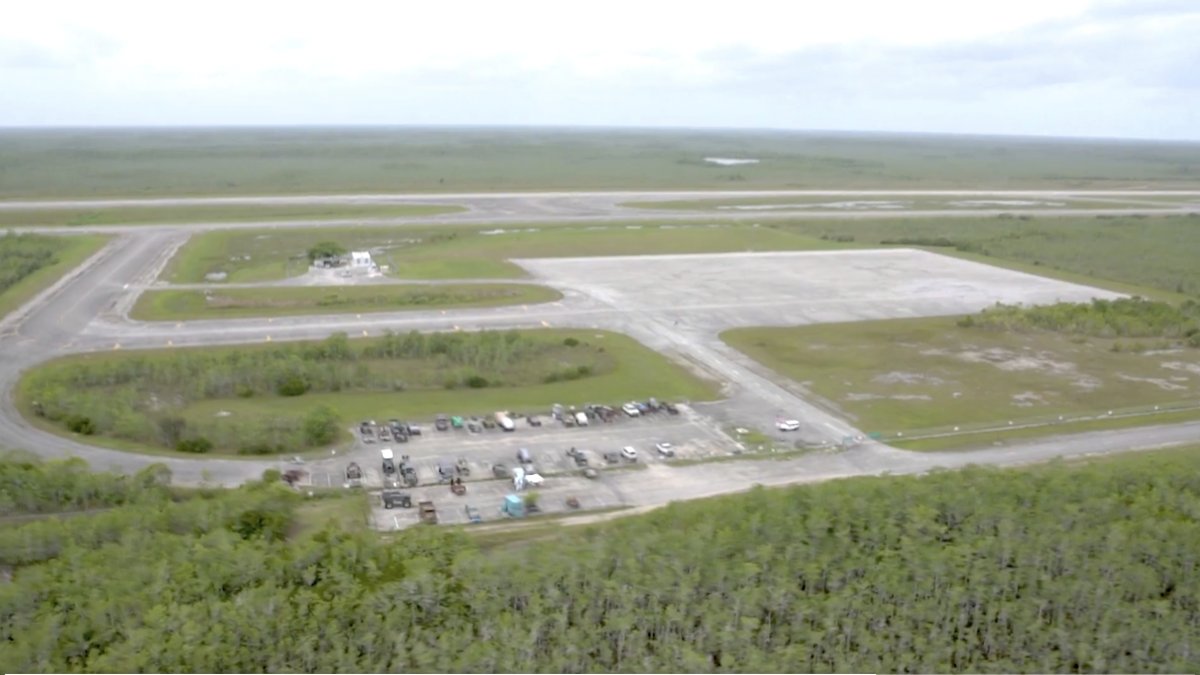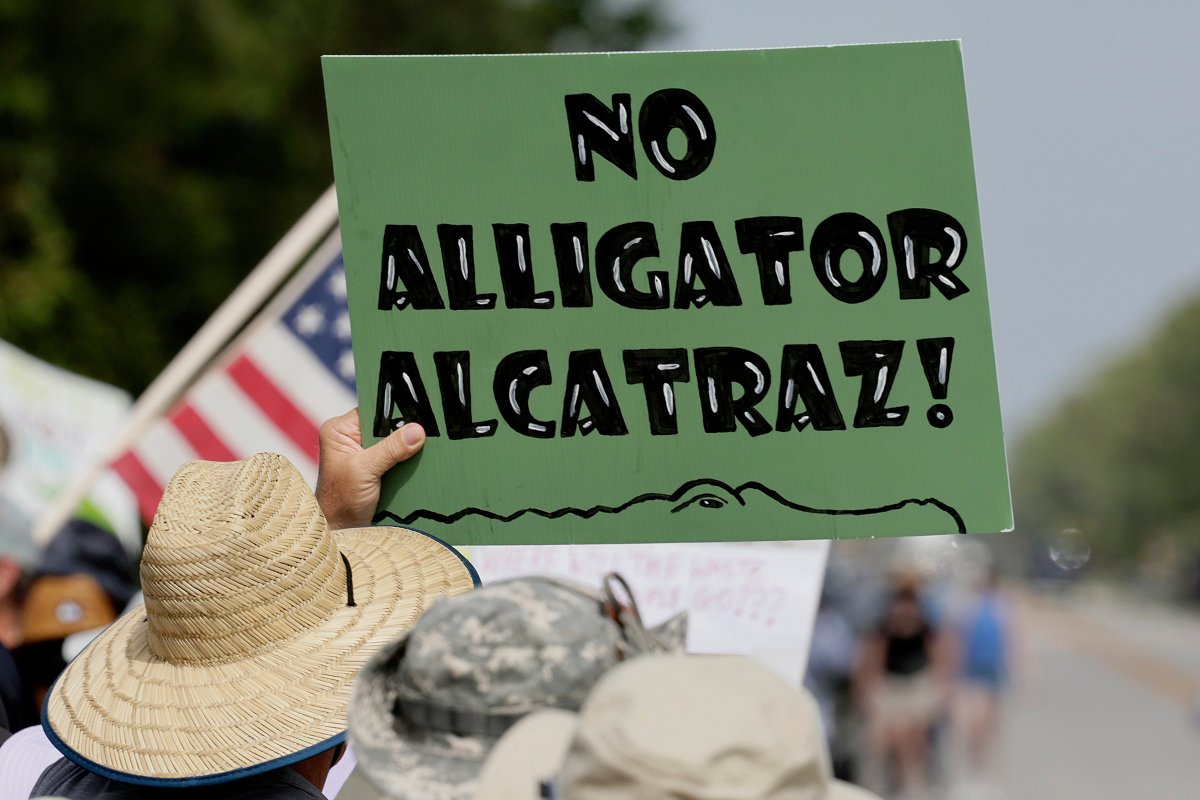Trump Admin Shares Meme of ICE Alligators Outside Florida Prison

The Department of Homeland Security has shared an apparently AI-generated meme depicting alligators as ICE agents outside of a Florida detention center.
“Alligator Alcatraz” is a new migrant detention center being developed on a remote airstrip in the Everglades. The facility aims to house up to 5,000 detainees and uses the area’s natural isolation and wildlife as part of its security measures.
“Coming soon!” DHS said in a post on X.
Newsweek has contacted DHS for comment via email outside of normal office hours.

DHS
Why It Matters
The remote facility is expected to cost Florida approximately $450 million annually to operate. The proposal comes as President Donald Trump’s administration looks to conduct what it describes as the largest mass deportation operation in U.S. history.
Critics say that the center’s remote location and rapid deployment raise ethical and legal questions about the treatment of migrants, transparency, and due process. Supporters say the project is a cost-efficient step to handle increased immigration enforcement.
What To Know
The image shared by DHS shows alligators wearing U.S. Immigration and Customs Enforcement (ICE) baseball caps outside the fences of the detention center.
The meme and plans have sparked outrage from critics over inhumane conditions and concerns from environmental groups.
“A horrendous lack of humanity,” Georgetown lecturer Brett Bruen, who served as director of global engagement during the Obama administration, said in a post on X.
Former CIA officer Christopher Burgess described the post as “Disgusting.”
The Florida Division of Emergency Management is set to build the facility, which is capable of housing up to 5,000 beds, according to DHS.

The Office of Attorney General James Uthmeier
This capacity is intended to support Florida’s expanded immigration enforcement efforts. The facility will detain individuals arrested by Florida law enforcement under the federal 287(g) program, as well as those transferred to Florida’s custody by U.S. Immigration and Customs Enforcement (ICE).
The initial phase of the facility is expected to be operational within days, providing 500 to 1,000 beds, with plans to expand in 500-bed increments until reaching full capacity by early July. The site will use soft-sided temporary structures initially, with possible permanent buildings added later. Housing will include renovated FEMA trailers previously used for disaster response, intended to be a cost-effective solution.
Managed by the State of Florida through the Division of Emergency Management, the facility benefits from the state’s declared emergency on immigration, allowing rapid mobilization. National Guard personnel trained under the 287(g) program will assist in operations. The projected cost is approximately $245 per bed per day, totaling around $450 million for the first year. The state plans to seek federal reimbursement through FEMA and the Department of Homeland Security, which have funds allocated for such efforts.
The concept for “Alligator Alcatraz” originated with Governor Ron DeSantis’s administration, utilizing his emergency powers authority to authorize a new detention site in the Everglades. Florida Attorney General James Uthmeier first publicly outlined the plan during an appearance on Fox News.

Mike Stocker/South Florida Sun-Sentinel via AP
Protests were held outside the site Saturday, with environmental activists and Native American groups advocating for the protection of ancestral lands converging near the airstrip in the Florida Everglades. Hundreds lined U.S. Highway 41, also known as Tamiami Trail, as dump trucks delivered materials to the construction site. Passing cars honked in support while protesters waved signs calling for the preservation of the expansive Everglades preserve, home to several endangered species and Native tribes.
The government fast-tracked the project under emergency powers from an executive order issued by DeSantis that addresses what he views as a crisis of illegal immigration. That order lets the state sidestep certain purchasing laws and is why construction has continued despite objections from Miami-Dade County Mayor Daniella Levine Cava and local activists.
What People Are Saying
DeSantis said Wednesday: “Clearly, from a security perspective, if someone escapes, you know, there’s a lot of alligators. No one’s going anywhere.”
Bacardi Jackson, Executive Director of the ACLU of Florida, said in a statement shared with Newsweek: “The name ‘Alligator Alcatraz’ reflects an intent to portray people fleeing hardship and trying to build a better life for themselves and their families as threats, which is both unnecessary and abusive.”
Renata Bozzetto, Deputy Director of the Florida Immigrant Coalition, said in a statement shared with Newsweek: “The rush to open this inhumane camp in July, during scorching hot Florida summer, while disappearing members of our communities— moms, dads, grandmothers, children—in tents in a swamp with no adequate facilities to sustain them, is simply meant and engineered to enact suffering.”
Kristi Noem, secretary for homeland security, said in a statement on Wednesday: “Under President Trump’s leadership, we are working at turbo speed to deliver cost-effective and innovative ways to deliver on the American people’s mandate for mass deportations of criminal illegal aliens.”
What Happens Next
The project could be finished within the next 30 to 60 days, according to Florida officials.



